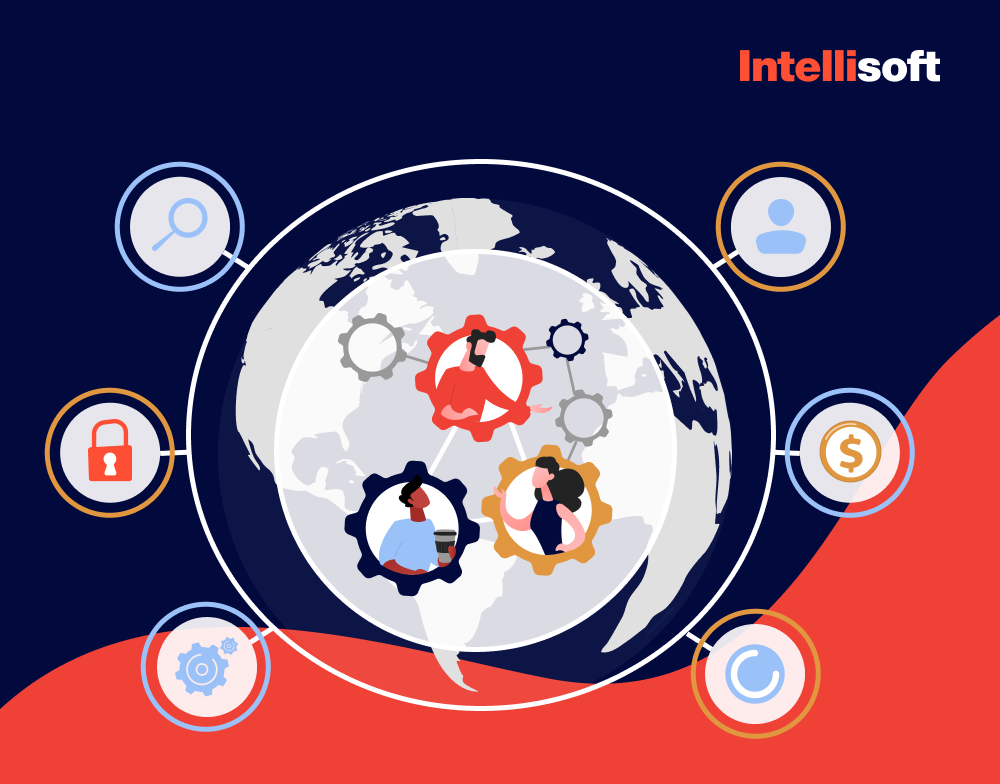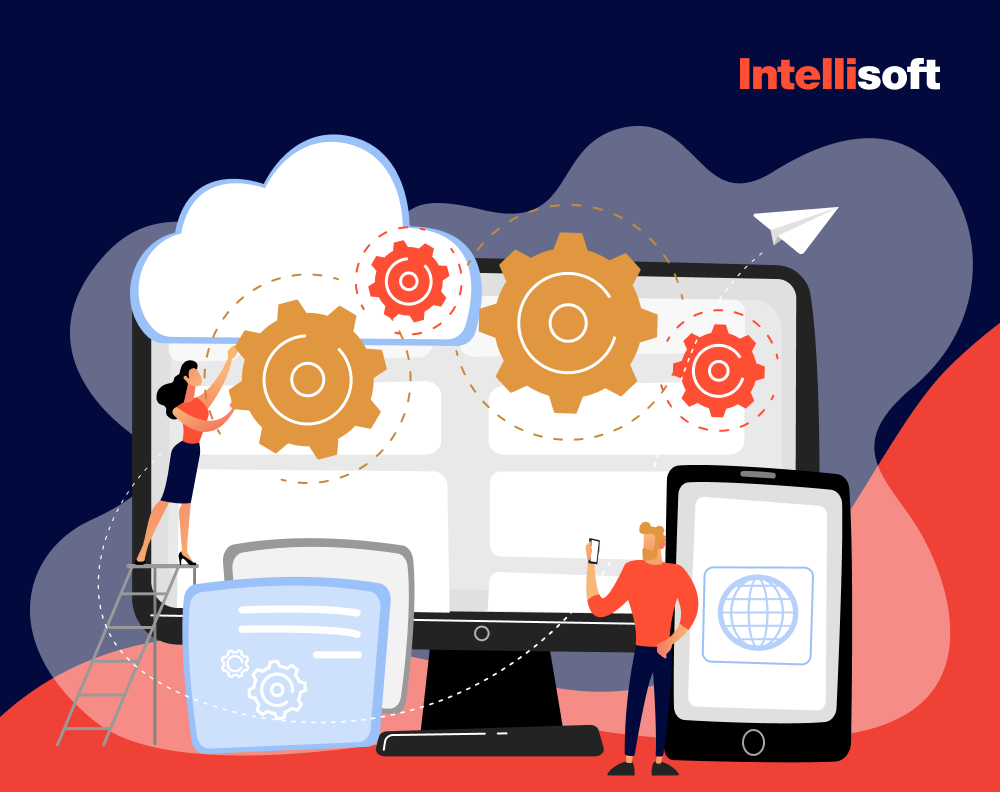Outsourcing has become popular as businesses aim to optimize operations and cut costs. However, picking risk mitigation strategies is more complex than choosing between Marvel and DC. Chief Information Officers (CIOs) now face increased regulatory scrutiny and must navigate through various third-party service providers, each with varying size, scope, and location. Furthermore, many companies already rely on multiple external service providers, some dependent on fourth and fifth parties.
With approximately 300,000 jobs being outsourced out of the United States each year, it is crucial to understand how to protect your company from the associated risks, no matter what type of outsourced staff you hire. In this article, we will explore how to identify risks in software development outsourcing and the precautions all companies hiring remote developers should take.
Table of Contents
Key Benefits of Outsourcing
When collaborating with a team that’s located remotely, it’s essential to complete thorough due diligence to establish trust and confidence. Although outsourcing may seem risky, it can offer many benefits if risk mitigation strategies are followed closely. Ensuring the remote team is reliable, competent, and compatible with your company’s goals and values is essential to building a fruitful partnership. By taking the following steps, you can reap the rewards of outsourcing and reduce the associated risks.
Cost Efficiency
Many industries today opt to outsource their software development needs as this can be a practical and cost-effective solution compared to maintaining an in-house team. This option is prevalent as it can help companies keep budgets, which is why 70% of companies choose outsourcing. Using this approach, companies can leverage the cost difference in labor rates, infrastructure, and operational expenses, resulting in decent savings. Besides, it allows businesses to focus on their core competencies and leave the technical aspects to specialized professionals, ensuring high-quality work and timely delivery of projects.
Access to Global Talent
Outsourcing offers a multitude of advantages to businesses, notably the opportunity to tap into a vast pool of diverse talent. Companies can harness the abilities and knowledge of a wide array of professionals from various fields, such as programmers, designers, writers, and engineers, enriching their projects with a range of valuable skills and insights.
Moreover, outsourcing affords businesses greater workforce flexibility. They can effortlessly adjust the size of their workforce to meet changing needs by accessing a broad spectrum of skilled professionals. This flexibility enables companies to swiftly capitalize on new opportunities without the concerns of recruiting or training additional staff.
Furthermore, outsourcing provides direct access to specialized experts. For example, a company looking to enhance its software development department can employ the services of a seasoned software development specialist, gaining tech expertise without compromising quality. This approach allows companies to benefit from the expertise of professionals with a history of success and experience in similar industries.
Focus on Core Competencies
Outsourcing certain operations allows a business to zero in on its primary activities, enhancing work quality and boosting efficiency. When a company diverts excessive time and resources to secondary tasks, it risks losing sight of its fundamental objectives, potentially leading to diminished employee morale and decreased productivity. By delegating these less critical tasks, a company can dedicate more attention to activities directly influencing its business goals.
Furthermore, outsourcing connects a company with specialists in specific fields, ensuring high-quality output and freeing up time to address other business facets.
Overall, outsourcing serves as a tool for businesses to refine their focus, achieve superior quality in their work, and enhance operational efficiency. This strategic narrowing of focus can be instrumental in fostering business growth and reaching new milestones.
Faster Time-to-Market
Often constrained by limited resources and tight timelines in software development, startups can find a viable solution in outsourcing these services. This approach enables them to expedite their products’ journey to the market. Collaborating with specialized development teams allows startups to benefit from continuous development cycles, efficient processes, and agile methodologies. Such collaboration leads to a quicker and more efficient development process, helping startups meet their product launch targets and secure a competitive edge. Outsourcing software development, not only provides a cost-effective option for startups, but also offers a scalable way to produce high-quality software in a timely manner.
Scalability and Flexibility
As companies grow rapidly, they must be prepared to meet new requirements. At this stage of development, many companies need to scale their IT support. However, finding resources for this task within the team can be expensive and impractical. These development teams are usually fixed in size and scope, and expanding an internal team to meet changing business needs can be costly and time-consuming. Therefore, partnering with an external vendor can be a viable option. It provides a scalable solution that can be easily expanded to meet your needs. Outsourcing helps companies respond faster to market changes and customer demands, and it also allows them to reduce overhead costs while increasing their operational agility.
Risk Mitigation: Understanding and Addressing Potential Challenges
Effective risk management is crucial in safeguarding the success of a project. Effective measures can be taken to prevent, minimize, or control their impact by identifying, analyzing, and evaluating potential risks and uncertainties. Taking a proactive approach to managing risks is essential, as this can help prevent potential threats and ensure sustained success. A complete risk mitigation strategy should include the following elements:
- Risk Identification. The first step in effective risk mitigation is identifying all potential risks that could threaten a project or business. Recognizing and accepting potential concerns, vulnerabilities, and risks is crucial for seamless implementation.
- Risk Assessment. Once potential risks have been identified, it is essential to assess them thoroughly to determine their likelihood of happening and their possible influence. This assessment evaluates several factors, including the severity of possible outcomes, the probability of the risk occurring, and the time it arises. By carefully considering these factors, businesses can better comprehend their risks and take appropriate steps to mitigate them.
- Risk Reduction Strategies. After conducting a risk assessment, companies create and implement strategies to minimize the likelihood and impact of identified risks. Risk mitigation strategies in project management may include altering procedures, improving security, diversifying resources, or implementing safeguards to reduce potential negative effects.
- Contingency Planning. Beyond reducing risks, effective risk mitigation also entails creating contingency plans. Risk mitigation planning details specific actions to execute if a risk becomes a reality, aiming to ensure a rapid and orderly response to reduce impact and support prompt recovery.
- Monitoring and Evaluation. Ongoing surveillance is vital to mitigate risks in a business setting. Regular reassessment and evaluation of the current risk mitigation strategies are critical, and you can adjust the chosen approach as necessary.
Adhering to these measures enables businesses to reduce the impact of potential risks and increase their likelihood of attaining their targeted results.

What Is a Risk Mitigation Plan?
A risk mitigation plan is a detailed document that assesses and manages potential risks that could affect the success of a project, initiative, or business operation. It contains a comprehensive roadmap that outlines specific actions, outsourcing risk mitigation strategies, and measures an organization will take to reduce the impact of identified risks. This plan helps organizations anticipate and prepare for potential dangers before they occur, thus enhancing their ability to achieve their goals and objectives.
What Are Risks of IT Outsourcing?
Most things have potential downsides in life and outsourced IT is no exception. When you open your business to a third party, you risk your business’s data, security, and operations. While most outsourced IT service providers are reputable companies that can improve your technology environment and provide many benefits, conducting proper research before hiring is essential. If fail to do so, there might be some consequences that you need to face.
Data Security Concerns
Opting to outsource IT services exposes companies to potential data security risks. Entrusting sensitive information to external providers can raise concerns regarding safeguarding data and maintaining privacy. Potential risks include unauthorized access, data breaches, and inadequate security measures that could expose sensitive data. Therefore, companies must exercise caution when sharing such information with third-party service providers.
Loss of Control
When a company decides to outsource its IT functions, it entrusts an external team responsible for developing and managing its technology systems. However, this also means that the company has to give up some control over the development process. As a result, there may be a lack of direct oversight, leading to challenges in managing project timelines, ensuring quality, and maintaining adherence to organizational standards. These challenges can significantly impact the project’s overall success and the company’s reputation.
Communication Challenges
It’s important to be aware of the hurdles that can come up when working on projects with people from around the world. According to PMI, poor communication is a factor in 56% of failed projects. This can be due to differences in language, which can lead to misunderstandings and misinterpretation of requirements. Time zone differences can also make real-time communication and collaboration difficult. Moreover, cultural differences can impact communication styles and expectations, resulting in ineffective cooperation. Companies must address these barriers to avoid project delays and misunderstandings that can negatively affect the project’s success.
Quality Assurance Issues
Maintaining high-quality standards in software deliverables can become challenging while collaborating with external vendors. This complexity arises from various factors, including mismatched quality benchmarks, varied testing approaches, and poor communication channels. These issues can lead to the final software product falling short of the anticipated quality, potentially causing problems and failing to achieve the intended results.
Hidden Costs
Although outsourcing can be attractive due to its potential cost savings, it’s essential to remember that hidden costs may be involved. These expenses could come in the form of additional fees for alterations to the project’s scope, unforeseen challenges that arise during the project, or costs related to fixing poorly executed tasks. Therefore, it’s critical to consider all potential expenses before outsourcing a project to ensure that the ultimate costs do not exceed the initial budget.
Legal and Compliance Risks
Navigating legal and compliance frameworks can be a complex and challenging task, mainly when operating in different regions across the globe. Fulfilling all contractual commitments, respecting intellectual property rights, and compiling industry regulations to avoid legal disputes and financial penalties are crucial. Failure to do so can have severe consequences for businesses, including damage to reputation, loss of revenue, and legal liabilities.

Related articles:
- How to Overcome Risks of Outsourcing
- Different Models of Team Effectiveness
- Lead Your Projects to Success with a Solid Project Team Structure
- Outsourcing-Partner Strategies: Achieving Project Scalability and Flexibility
- Outsourced Development Team: Mastering Collaboration for Building Productive Partnerships
Mitigation Strategies for IT Outsourcing Risks
Companies adopt multiple proactive approaches to protect themselves while outsourcing to avoid potential complications and minimize risks. Here are examples of risk mitigation strategies:
Data Security Measures
Implementing robust security measures such as encryption, secure channels of communication, and access controls is crucial. Define data protection requirements in contracts and regularly conduct security audits to identify and address potential vulnerabilities. Prioritizing adherence to industry standards is essential to ensure that your data security protocols are robust and effective. By using these risk mitigation strategies, you can mitigate the risk of data breaches and protect your sensitive information from unauthorized access.
Contractual Clarity and Control
Create detailed contracts outlining the project’s expectations, timelines, and quality benchmarks. Setting KPIs and milestones in contracts is vital to control project progress. Regularly reviewing and updating these contracts should be done as they are necessary to ensure all parties know their responsibilities throughout the project’s lifecycle.
Effective Communication
Specifying transparent and open communication channels between the client and the outsourcing partner is essential. You can implement this risk mitigation strategy using collaboration tools, regular meetings, and establishing reporting and issue-resolution protocols. The parties involved can also receive training on communication best practices to enhance their skills and minimize misunderstandings. Effective communication enables both parties to collaborate smoothly and attain shared objectives.
Quality Assurance Protocols
Defining and documenting the standards is vital to ensure quality assurance in an outsourcing relationship. Maintaining consistency and reducing errors in the project can be achieved through this approach. Besides, adopting strict testing protocols and regular code reviews will assist in quickly identifying and resolving any issues that arise. Setting a feedback loop for continuous improvement is also recommended, as it allows for ongoing assessment and refinement of the process. Furthermore, independent third-party audits can provide an extra layer of assurance and help ensure meeting quality standards.
Diversification and Redundancy
It is advisable to steer clear of relying too heavily on a single outsourcing partner. Instead, it is best to distribute your projects across multiple vendors or adopt a multi-vendor approach. This can help mitigate the adverse effects of disruptions caused by any vendor’s problems. By diversifying your outsourcing partnerships, you can better safeguard your business operations and avoid potential losses.
Transparent Cost Structures
Ensuring the outsourcing contract contains a comprehensive and transparent cost structure is essential. It should include a detailed breakdown of all costs, payment terms, and any potential additional expenses that may arise. Furthermore, defining clear conditions for any project scope changes is crucial. Regular financial reviews of the outsourcing contract should be conducted to promptly address any unexpected costs and ensure economic viability, which can prevent future disputes.
Legal Due Diligence
When entering into a business agreement, it is crucial to engage legal experts to review all the contracts involved thoroughly. These experts can ensure that the contracts address critical issues such as intellectual property rights, data ownership, and compliance with all relevant laws and regulations. Besides, it is crucial to clearly define the mechanisms for dispute resolution and establish legal frameworks that align with the interests of all parties involved. Implementing a risk mitigation strategy can help protect your business interests and minimize the risk of legal disputes.
Risk Analysis and Contingency Planning
Carry out a thorough risk assessment at the onset of any outsourcing partnership. This will involve identifying potential risks and developing a comprehensive plan to manage them if they materialize. The plan should include:
- Measures to mitigate geopolitical and economic uncertainties
- Fluctuations in vendor performance
- Other potential disruptions that may arise during the partnership
By doing this, both parties can ensure that the outsourcing arrangement remains stable and productive despite unforeseen challenges.
Knowledge Transfer Strategies
To ensure that knowledge is transferred effectively within a project team, it is essential to establish a comprehensive plan that includes documentation, training sessions, and regular team interactions. Encouraging a knowledge-sharing culture and active participation from both the client and vendor teams can significantly improve the quality of knowledge transfer activities. Businesses can enhance their overall performance and achieve extraordinary success by allowing team members to share their expertise and collaborate on projects.
Continuous Monitoring and Evaluation
By implementing ongoing monitoring mechanisms, you can guarantee the successful completion of any project. These mechanisms should track and analyze various aspects, such as project progress, vendor performance, and compliance with contractual obligations. By regularly evaluating key performance indicators and conducting periodic reviews, you can identify and address potential risks that may emerge during the project’s lifecycle. This approach enables you to take timely corrective actions, ensuring the project’s smooth and timely delivery.
All these risk mitigation strategies examples are crucial for further project success.

Mitigating Outsourcing Risks With IntelliSoft
Collaborating with an external software development company can bring numerous advantages but also involves risks that companies should address. However, there are risk mitigation strategies in project management that minimize risks and ensure fruitful cooperation between your company and the vendor. Choosing the right partner can establish a healthy and successful collaboration to drive your business forward.
At IntelliSoft, we understand the importance of effective cooperation with external partners, and have gained valuable experience through numerous successful partnerships with clients; check out our portfolio to see more. We believe that our expertise can help you achieve your business goals, and we are always ready to answer any questions about software development outsourcing. Contact us today to learn how we can support your lightning-speed journey to success.










